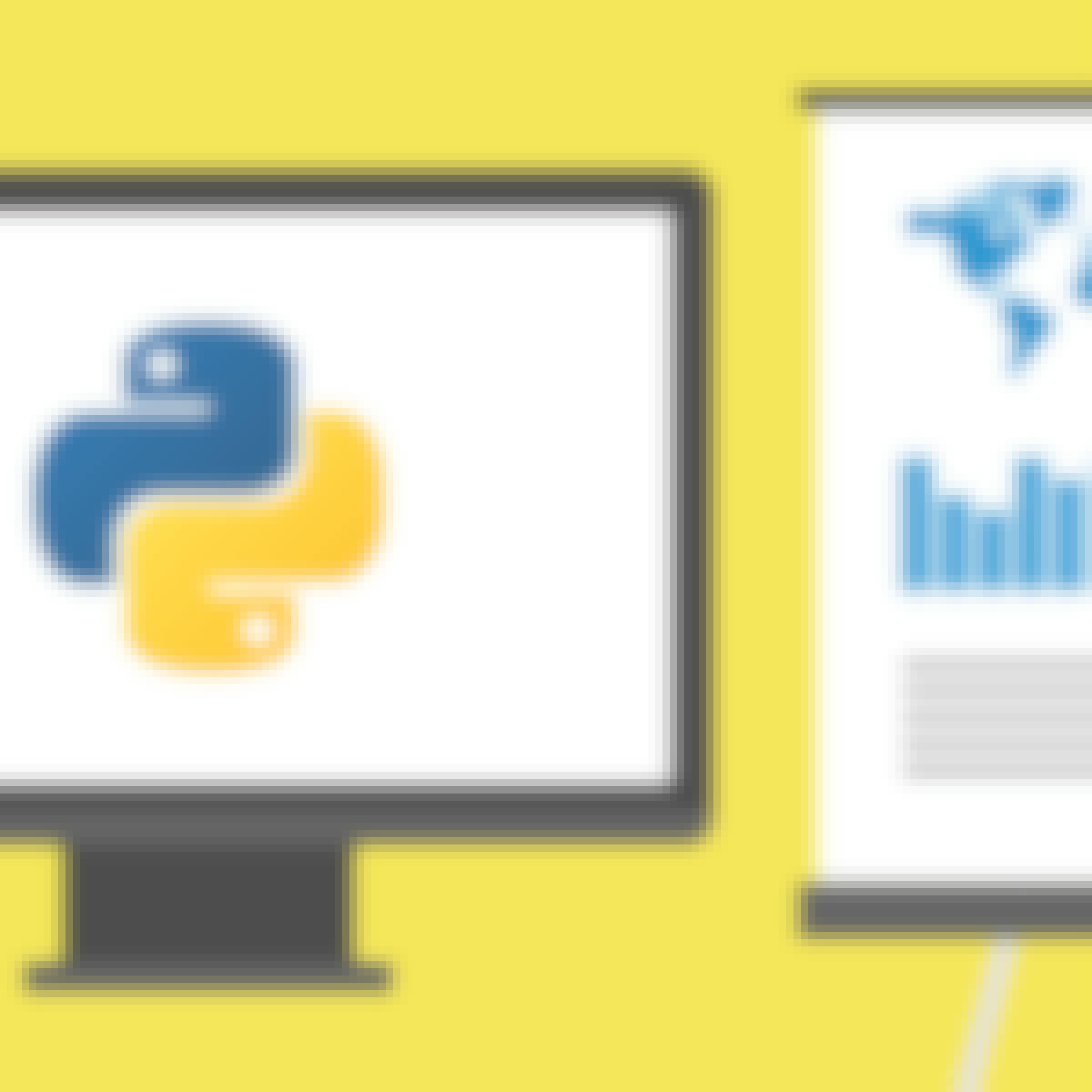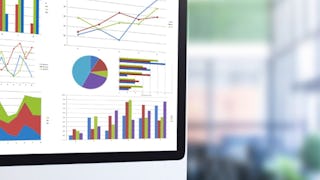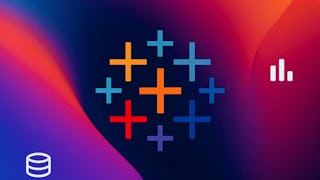- Browse
- Data Visualization
Data Visualization Courses
Data visualization courses can help you learn how to create compelling charts, graphs, and dashboards, along with understanding data storytelling and visual design principles. You can build skills in interpreting data trends, selecting appropriate visual formats, and conveying insights effectively to diverse audiences. Many courses introduce tools like Tableau, Power BI, and D3.js, that support transforming raw data into visual narratives and making data-driven decisions in various fields.
Popular Data Visualization Courses and Certifications
 Status: Free TrialFree Trial
Status: Free TrialFree TrialSkills you'll gain: Data Visualization Software, Plotly, Data Visualization, Dashboard, Interactive Data Visualization, Matplotlib, Seaborn, Data Presentation, Data Analysis, Geospatial Information and Technology, Pandas (Python Package), Scatter Plots, Histogram, Heat Maps, Box Plots, Python Programming
4.5·Rating, 4.5 out of 5 stars12K reviewsIntermediate · Course · 1 - 3 Months
 Status: Free TrialFree Trial
Status: Free TrialFree TrialSkills you'll gain: Data Storytelling, Data Presentation, Interactive Data Visualization, Data Visualization, Dashboard, Data Visualization Software, IBM Cognos Analytics, Microsoft Excel, Looker (Software), Scatter Plots, Tree Maps, Pivot Tables And Charts, Histogram, Data Analysis
4.7·Rating, 4.7 out of 5 stars4.4K reviewsBeginner · Course · 1 - 4 Weeks
 Status: Free TrialFree TrialM
Status: Free TrialFree TrialMMicrosoft
Skills you'll gain: Data Storytelling, Data Analysis Expressions (DAX), Data Presentation, Power BI, Data Ethics, Dashboard, Data Modeling, Data Governance, Extract, Transform, Load, Data Visualization, Interactive Data Visualization, Business Intelligence, Data Visualization Software, Data Analysis, Statistical Analysis, Correlation Analysis, Data Architecture, Data Cleansing, Data Transformation, Database Design
4.7·Rating, 4.7 out of 5 stars139 reviewsBeginner · Professional Certificate · 3 - 6 Months
 Status: Free TrialFree Trial
Status: Free TrialFree TrialSkills you'll gain: Data Storytelling, Data Literacy, Data Visualization, Data Presentation, Tableau Software, Presentations, Data Visualization Software, Dashboard, Data Analysis, Web Content Accessibility Guidelines, Stakeholder Engagement
4.6·Rating, 4.6 out of 5 stars9.8K reviewsBeginner · Course · 1 - 4 Weeks
 Status: Free TrialFree TrialU
Status: Free TrialFree TrialUUniversity of California, Davis
Skills you'll gain: Dashboard, Data Storytelling, Tableau Software, Data Presentation, Data Visualization, Visual Design, Advanced Analytics, Stakeholder Analysis, Interactive Data Visualization, Data Visualization Software, Design, Data Literacy, Exploratory Data Analysis, Proposal Development, Data Ethics, Data Analysis, Graphing, Visualization (Computer Graphics), Pivot Tables And Charts, Storyboarding
4.5·Rating, 4.5 out of 5 stars8.3K reviewsBeginner · Specialization · 3 - 6 Months
 Status: Free TrialFree TrialJ
Status: Free TrialFree TrialJJohns Hopkins University
Skills you'll gain: Data Visualization Software, Scientific Visualization, Interactive Data Visualization, Geospatial Information and Technology, Data Presentation, Color Theory, Graphic and Visual Design, Tree Maps, Visualization (Computer Graphics), Data Storytelling, Design Elements And Principles, Plot (Graphics), Data Literacy, Heat Maps, Computer Displays, Exploratory Data Analysis, Time Series Analysis and Forecasting, Data Mapping, Scatter Plots, Scalability
Intermediate · Specialization · 3 - 6 Months
What brings you to Coursera today?
 Status: Free TrialFree Trial
Status: Free TrialFree TrialSkills you'll gain: Data Visualization, Data Presentation, Dashboard, Data Storytelling, Data Visualization Software, Microsoft Excel, Spreadsheet Software, Excel Formulas, Graphing, Pivot Tables And Charts, Data Modeling, Databases, Data Analysis, Simulation and Simulation Software
4.8·Rating, 4.8 out of 5 stars3K reviewsBeginner · Course · 1 - 4 Weeks
 Status: Free TrialFree TrialU
Status: Free TrialFree TrialUUniversity of Illinois Urbana-Champaign
Skills you'll gain: Data Visualization, Data Visualization Software, Data Presentation, Interactive Data Visualization, Data Storytelling, Dashboard, Tableau Software, Plot (Graphics), Scatter Plots, Data Mapping, Graphing
4.5·Rating, 4.5 out of 5 stars1.4K reviewsMixed · Course · 1 - 3 Months
 C
CCoursera
Skills you'll gain: Data Visualization, Data Literacy, Data Presentation, Google Sheets, Data Compilation, Data Visualization Software, Graphing, Spreadsheet Software
4.7·Rating, 4.7 out of 5 stars440 reviewsBeginner · Guided Project · Less Than 2 Hours
 Status: Free TrialFree TrialM
Status: Free TrialFree TrialMMacquarie University
Skills you'll gain: Pivot Tables And Charts, Data Storytelling, Data Visualization Software, Data Visualization, Interactive Data Visualization, Spreadsheet Software, Dashboard, Microsoft Excel, Excel Macros, Infographics, Data Analysis, Data Manipulation, Forecasting
4.9·Rating, 4.9 out of 5 stars1.3K reviewsIntermediate · Course · 1 - 3 Months
 Status: Free TrialFree TrialU
Status: Free TrialFree TrialUUniversity of Colorado Boulder
Skills you'll gain: Dashboard, Data Visualization Software, Tableau Software, Data Visualization, Interactive Data Visualization, Data Storytelling, Data Presentation, Data Analysis, Statistical Visualization, Geospatial Mapping, Histogram, Advanced Analytics, Spatial Analysis, Scatter Plots, Data Science, Data Manipulation, Business Analytics, Marketing Analytics, Analytics, Forecasting
5·Rating, 5 out of 5 stars6 reviewsBeginner · Specialization · 1 - 3 Months
 Status: Free TrialFree TrialT
Status: Free TrialFree TrialTTableau Learning Partner
Skills you'll gain: Data Storytelling, Exploratory Data Analysis, Requirements Elicitation, Data Presentation, Data Governance, Data Ethics, Tableau Software, Business Analysis, Data Literacy, Data Visualization, Data Visualization Software, Data Warehousing, Business Metrics, Dashboard, Extract, Transform, Load, Stakeholder Analysis, Data Analysis, Spatial Data Analysis, Data Quality, Data Management
4.7·Rating, 4.7 out of 5 stars1.1K reviewsBeginner · Professional Certificate · 3 - 6 Months
Searches related to Data Visualization
In summary, here are 10 of our most popular Data Visualization courses
- Data Visualization with Python: IBM
- Data Visualization and Dashboards with Excel and Cognos: IBM
- Microsoft Data Visualization: Microsoft
- Share Data Through the Art of Visualization: Google
- Data Visualization with Tableau: University of California, Davis
- Data Visualization: Johns Hopkins University
- Data Visualization with Advanced Excel: PwC
- Data Visualization: University of Illinois Urbana-Champaign
- Overview of Data Visualization: Coursera
- Data Visualization in Excel: Macquarie University
Frequently Asked Questions about Data Visualization
Data visualization, which is sometimes called information visualization, is the representation of datasets through graphical means such as charts, maps, visual analytics interfaces such as dashboards, and interactive visualizations. A picture is worth a thousand words - or a thousand lines of a spreadsheet - and the ability to convey key relationships within complex datasets and insights from data analysis in a visually compelling way is critically important to making sense of our world.
While data visualizations may be as simple as a bar graph created in Microsoft Excel, the complexity, size, and velocity of datasets in the big data era often demand more powerful approaches. Specialized programs such as Tableau Software and the D3.js JavaScript library are widely used in the business world to create dynamic data visualizations, which may even incorporate real-time data streams. For particularly complex tasks, data virtualization software may also be used as middleware to integrate multiple sources and types of data into a format suitable for use with these visualization programs.
The ability to create data visualizations are increasingly expected in a variety of jobs, making these skills highly valuable as well as portable. Whether you’re a financial analyst at a hedge fund displaying a real-time dashboard of portfolio risk or a data journalist creating an interactive visualization map of the spread of Covid-19, compelling data visualizations can increase the impact of your work and give you an edge in your career.
Management analysts are particularly attuned to the value of good data visualizations. These consultants must make convincing recommendations for organizational changes to upper-level management and busy executives, and powerful graphics can be essential to making these cases effectively. According to the Bureau of Labor Statistics, management analysts earned a median annual wage of $85,260 as of 2019, and these jobs are expected to grow much faster than average as more and more companies seek advice on navigating today’s fast-changing business world.
Yes! Coursera lets you learn remotely about data visualization and related topics with courses and Specializations from top-ranked schools like New York University, University of California, Davis, and the University of Illinois at Urbana-Champaign. You can also take courses from industry leaders like IBM and PwC, one of the top management consultancies in the world. Online learning with Coursera is an especially good fit for mid-career professionals seeking to add data visualization capabilities to their skill set, as you can complete coursework on a flexible schedule that fits into your existing work life.
Some skills you might want to have before learning data visualization include mathematics, Excel, and some coding experience. Specifically, learning popular programming languages like R and Python can be useful for analyzing the data you want to present in a visual format. Strong data analysis skills are usually essential because you should be able to interpret data accurately to avoid misleading the people viewing the final product. In addition to technology skills, you can put to use other skills in a data visualization role, such as problem-solving, artistic skills, and communication skills.
The right kind of person for a role in data visualization has a combination of technology, business, and communication skills. They typically know how to collect, analyze, and interpret data quickly and accurately using programming languages like R, Python, and JavaScript and tools such as Tableau, PowerBI, or Microsoft Excel. Someone with strong communication skills also tends to work well in this field. Being able to listen to the needs of the client and create a data visualization tool that accurately represents the data in a way that the audience understands is useful.
If you're comfortable working with large amounts of data and are passionate about making sure people understand the available data about a project, program, or concern, learning data visualization may be a good choice for you. You'll likely have opportunities to help others by sharing important data in a format that’s visually appealing and easy to interpret. Learning data visualization can add to your skillset if you've previously studied or worked as a graphic designer or data analyst. You may choose to learn a programming language so you can develop your own data warehouse or another visualization tool to showcase the data you analyze, or you can decide to explore the variety of methods used to create visual displays of data.
If you're looking for the best free data visualization courses available, try auditing one of these courses Data Visualization Specialization, Excel Data Analytics and Visualization Specialization, Fundamentals of Data Visualization Course, Data Visualization and Dashboarding with R Specialization or Data Analysis and Visualization Foundations Specialization. In the audit version, you can assess most of the material but will not be able to submit assignments or receive grades or a certificate for your work unless you upgrade.
For those seeking to get started in data visualization, the Data Visualization with Tableau offers valuable insight into topics such as practices, theories, and tools used in data visualization. Additionally, the Data Analysis and Visualization Foundations Specialization covers the fundamentals of data visualization. For those wishing to learn R programming for data visualization methods, the Data Visualization and Dashboarding with R Specialization is a great option. Those looking for data visualization with Python can sign up for Python for Data Visualization and for Tableau, Data Visualization with Tableau provides an introduction to analytics and data visualization.
For those looking to excel in advanced data visualization, Coursera offers an extensive range of courses. These include the Excel, Data Visualization & Analytics Specialization, Fundamentals of Data Visualization, Python for Data Visualization, Excel for Data Visualization, and Data Visualization Project.
Online Data Visualization courses offer a convenient and flexible way to enhance your knowledge or learn new Data Visualization skills. Choose from a wide range of Data Visualization courses offered by top universities and industry leaders tailored to various skill levels.
When looking to enhance your workforce's skills in Data Visualization, it's crucial to select a course that aligns with their current abilities and learning objectives. Our Skills Dashboard is an invaluable tool for identifying skill gaps and choosing the most appropriate course for effective upskilling. For a comprehensive understanding of how our courses can benefit your employees, explore the enterprise solutions we offer. Discover more about our tailored programs at Coursera for Business here.










